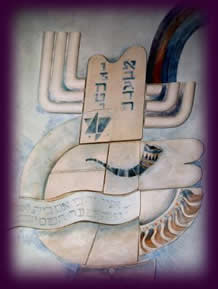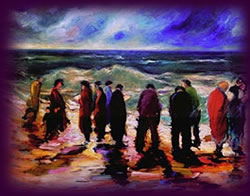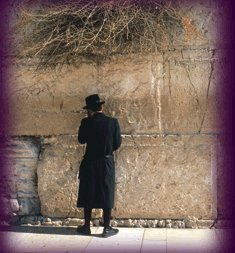
Detail of wall art from synagogue in
Paradise Springs, Arizona showing a
shofar and the tablets of the law
The oracle of the Jews is the Torah, a Hebrew word which means ‘instruction, teaching, law.’ It refers generally to the Hebrew Bible, and specifically to its first five books, believed to be delivered to the prophet Moses on Mount Sinai.
On
the first day of the seventh month hold a sacred assembly...
It is a day for you to sound the shofar...
Numbers 29: 1
The shofar—the oldest known horn—has survived as a ritual implement throughout the entire history of the Jewish people. Of martial origin*, it was used by priests in biblical times to call the people to assembly. According to the Mishna**, two different forms of shofar were used in the temple at Jerusalem. One, made of ram’s horn with silver ornamentation, was sounded on fast days; the other, made of ibex horn, its bell ornamented with gold, was saved for the New Year and the subsequent days of awe.
The Jewish New Year, Rosh Hashanah (‘head of the year’) was originally called Yom Teruah, ‘the day of sounding of trumpets’. Elsewhere the Bible refers to it as Yom Ha-Zikkaron, ‘the day of remembrance’, and the sounding of the shofar is one of the most important observances, arousing individuals from their spiritual complacency and reminding them of the need to repent and reconnect.
*Note,
for example, the biblical story of Joshua before the walls of Jericho:
“The seventh time around, when the priests sounded the trumpet blast,
Joshua commanded the people, ‘Shout! For the Lord has given you
the city!’”
**The first and principle part of the Talmud, which attempts to codify,
explain, and define Old Testament law.

Taschlich,
by Zvi Malnovitzer
On
the first day of Rosh Hashanah,
the ritual of taschlich is performed. Crumbs of bread are tossed
into water and the hems of garments are shaken, alluding to the fact that
sins are being cast away.
Who
is a God like you, who pardons sin
and forgives...transgression[s]?
You do not stay angry forever but delight to show mercy.
You will again have compassion on us;
you will tread our sins underfoot
and hurl all our iniquities into the depths of the sea.
Micah* 7:18-19
The ten days starting with Rosh Hashanah and ending with Yom Kippur are commonly known as the ‘days of awe’ or the ‘days of repentance’. For Jews this is a most auspicious time, a period sanctified for serious introspection, when the previous year’s sins can be repented and symbolically shed during the ritual known as taschlich, ‘casting off’.
It is said that on Rosh Hashanah God decrees the fate of every individual for the coming year. During the subsequent days of awe individuals are given the chance to alter this fate through prayer, repentance and good deeds. However on Yom Kippur, the ‘day of atonement’, this book of fate is sealed. Hence the greeting: “May you be inscribed and sealed for a good year.”
*One of the prophets of the Hebrew Bible.

Praying at the western wall, Jerusalem
The most sacred spot in Jewish religious and national consciousness is the ‘western wall’ in Jerusalem, all that remains of the second temple that was burned to the ground in 70 CE. When the holy of holies was destroyed—so some believe—the ‘eternal presence’ was transferred to this one remaining remnant; as a focus for mourning it has come to be known as the ‘wailing wall’.
This
is my change, this is my compensation,
this is my redemption...
From
the ritual of kapparot
The English term ‘atonement’ was originally coined in 1526 CE by the Reformation leader William Tyndale to translate the Latin term reconciliatio, which means ‘to bring together again, conciliate, or restore to union’. The festivals of Rosh Hashanah and Yom Kippur provide a communally sanctioned time for Jews to get back into balance, and to reconcile themselves with the day-to-day struggle to do right.
Life is hard, and there are so many things that can go wrong during the course of it; who among us has not done something for which we feel remorse? There are actions that spite no one but ourselves, and there are wrongs against others. On the day before Yom Kippur, Erev Yom Kippur, it is customary to visit any person one has injured during the year to seek reconciliation and forgiveness.
The practice of kapparot—also performed on Erev Yom Kippur— originally involved the transfer of a person’s ‘sins’ to a chicken, which was then ritually slaughtered. Nowadays, if kapparot is observed, it is done with money that is put in a handkerchief, swung round the head and subsequently donated to the poor. Whereas it no longer seems right to ask an animal to pay for our redemption, there are innocent mistakes we all make that nonetheless haunt us; the modern method of performing the ritual is an act of charity that can also alleviate an unnecessary burden of guilt.